A Double-Bridge Channel Shape of a Membraneless Microfluidic Fuel Cell
Abstract
:1. Introduction
2. MMFC Geometry
3. Numerical Analysis
4. Results and Discussion
5. Conclusions
- (1)
- In comparison to the single-bridge channel, the reference double-bridge channel with equal sub-channel widths showed a 34.0% higher peak power density (31.88 mW/cm2), which demonstrates the superiority of the proposed MMFC flow channel shape.
- (2)
- The effects of the sub-channel widths (WI, WB, and WO) with the fixed total channel width and the bridge height (h) of the double-bridge channel on the performance were further investigated. Among the sub-channel widths, the width of the inner channel (WI) was found to be the most influential on the power density of the MMFC. Thus, the case with a fixed WI showed the least variation of the power density.
- (3)
- In the case with fixed WB or fixed WO, the power density increased with WI. The main reason was proved to be the reduced thickness of the mixing region in the inner channel with the increased WI. In the case with fixed WB/Wr = 1.0, WI/Wr = 1.7 (WO/Wr = 0.3) showed about an 18% higher peak power density compared to the reference channel. However, compared to this case, with varying WO, the case with fixed WO/Wr = 1.0 showed more than double a larger variation in the peak power density in the range of WI/Wr = 0.4–1.3. This is because the negative effects of varying WO, such as reducing the area around the electrode in the outer channel and increasing the distance between the electrodes, were removed in this case. WB/Wr = 0.7 (WI/Wr = 1.3) showed about a 15% higher peak power density than that of the reference channel.
- (4)
- The height of the double-bridge structure had the greatest effect on performance, as expected. As h/H increased, the peak power density reached a maximum at h/H = 0.9, which was 171% higher than that of the reference channel (h/H = 0.2). The concentration contours of fuel showed that the thickness of the mixing region reduced as h increased, and the reduction rate was higher for smaller h/H.
Author Contributions
Funding
Institutional Review Board Statement
Informed Consent Statement
Data Availability Statement
Conflicts of Interest
Nomenclature
| Surface area (m2) | Greek symbols | ||
| Species concentration (mol) | Charge transfer coefficient | ||
| Diffusivity (m2/s) | Overpotential (V) | ||
| Number of moles | Fluid viscosity (Pa s) | ||
| Faraday constant (C/mol) | Fluid density (kg/m3) | ||
| Bridge height (µm) | Conductivity (S/m) | ||
| Exchange current density (A/m) | Local potential (V) | ||
| Current | Liquid-phase local potential (V) | ||
| Current normal to the surface | Reversible potential (V) | ||
| Length of microchannel (mm) | Solid-phase local potential (V) | ||
| Unit normal vector | |||
| Pressure (Pa) | |||
| Gas constant (J/mol K) | |||
| Source term | |||
| Temperature (K) | |||
| Velocity vector (m/s) | |||
| Channel half-width (µm) | |||
| Bridge channel width (µm) | |||
| Inner channel width (µm) | |||
| Outer channel width (µm) | |||
| Reference width (µm) | |||
References
- Kamarudin, S.K.; Daud, W.R.W.; Som, A.M.; Takriff, M.S.; Mohammad, A.W.; Loke, Y.K. Design of a fuel processor unit for PEM fuel cell via shortcut design method. Chem. Eng. J. 2014, 104, 7–17. [Google Scholar] [CrossRef]
- Achmad, F.; Kamarudin, S.K.; Daud, W.R.W.; Majlan, E.H. Passive direct methanol fuel cells for portable electronic devices. Applied Energy 2011, 88, 1681–1689. [Google Scholar] [CrossRef]
- Dyer, C.K. Fuel cells for portable applications. J. Power Sources 2002, 106, 31–34. [Google Scholar] [CrossRef]
- Kjeang, E.; Djilali, N.; Sinton, D. Microfluidic fuel cells: A review. J. Power Sources 2009, 186, 353–369. [Google Scholar] [CrossRef]
- Lee, S.J.; Chang-Chien, A.; Cha, S.W.; O’Hayre, R.; Park, Y.I.; Saito, Y.; Prinz, F.B. Design and fabrication of a micro fuel cell array with ‘‘flip-flop’’ interconnection. J. Power Sources 2002, 112, 410–418. [Google Scholar] [CrossRef]
- Motokawa, S.; Mohamedi, M.; Momma, T.; Shoji, S.; Osaka, T. MEMS-based design and fabrication of a new concept micro direct methanol fuel cell (l-DMFC). Electrochem. Commun. 2004, 6, 562–565. [Google Scholar] [CrossRef]
- Pan, Z.F.; An, L.; Zhao, T.S.; Tang, Z.K. Advances and challenges in alkaline anion exchange membrane fuel cells. Prog. Energy Combust. Sci. 2018, 66, 141–175. [Google Scholar] [CrossRef]
- Pan, Z.F.; Chen, R.; An, L.; Li, Y.S. Alkaline anion exchange membrane fuel cells for cogeneration of electricity and valuable chemicals. J. Power Sources 2017, 365, 430–445. [Google Scholar] [CrossRef]
- An, L.; Chen, R. Direct formate fuel cells: A review. J. Power Sources 2016, 320, 127–139. [Google Scholar] [CrossRef]
- Xiao, Z.Y.; Feng, C.H.; Chan, P.C.H.; Hsing, I.M. Monolithically integrated planar microfuel cell arrays. Sens. Actuators B 2008, 132, 576–586. [Google Scholar] [CrossRef]
- Yeom, J.; Mozsgai, G.Z.; Flachsbart, B.R.; Choban, E.R.; Asthana, A.; Shannon, M.A.; Kenis, P.J.A. Microfabrication and characterization of a silicon-based millimeter scale, PEM fuel cell operating with hydrogen, methanol, or formic acid. Sens. Actuators B 2005, 107, 882–891. [Google Scholar] [CrossRef]
- Yu, J.G.; Cheng, P.; Ma, Z.Q.; Yi, B.L. Fabrication of a miniature twin-fuel-cell on silicon wafer. Electrochim. Acta 2003, 48, 1537–1541. [Google Scholar] [CrossRef]
- Patil, A.; Dubois, T.G.; Sifer, N.; Bostic, E.; Gardner, K.; Quah, M.; Bolton, C. Portable fuel cell systems for America’s army: Technology transition to the field. J. Power Sources 2004, 136, 220–225. [Google Scholar] [CrossRef]
- Frank, M.; Erdler, G.; Freichs, H.P.; Muller, C.; Reinecke, H. Chip integrated fuel cell accumulator. J. Power Sources 2008, 181, 371–377. [Google Scholar] [CrossRef]
- Moore, C.W.; Li, J.; Kohl, P.A. Microfabricated Fuel Cells with Thin-Film Silicon Dioxide Proton Exchange Membranes. J. Electrochem. Soc. 2005, 152, A1606–A1612. [Google Scholar] [CrossRef]
- Choban, E.R.; Spendelow, J.S.; Gancs, L.; Wieckowski, A.; Kenis, P.J.A. Membraneless c-based micro fuel cells operating in alkaline, acidic, and acidic/alkaline media. Electrochim. Acta 2005, 50, 5390–5398. [Google Scholar] [CrossRef]
- López-Montesinos, P.O.; Yossakda, N.; Schmidt, A.; Brushett, F.R.; Pelton, W.E.; Kenis, P.J.A. Design, fabrication, and characterization of a planar, silicon-based, monolithically integrated micro laminar flow fuel cell with a bridge-shaped microchannel cross-section. J. Power Sources 2001, 196, 4638–4645. [Google Scholar] [CrossRef]
- Tanveer, M.; Kim, K.Y. Effects of geometric configuration of the channel and electrodes on the performance of a membraneless micro-fuel cell. Energy Convers. Manag. 2017, 136, 372–381. [Google Scholar] [CrossRef]
- Hollinger, A.S.; Maloney, R.J.; Jayashree, R.S.; Natarajan, D.; Markoski, L.J.; Kenis, P.J.A. Nanoporous separator and low fuel concentration to minimize crossover in direct methanol laminar flow fuel cells. J. Power Sources 2010, 195, 3523–3528. [Google Scholar] [CrossRef]
- Choban, E.R.; Markoski, L.J.; Wieckowski, A.; Kenis, P.J.A. Microfluidic fuel cell based on laminar flow. J. Power Sources 2004, 128, 54–60. [Google Scholar] [CrossRef]
- Sprague, I.B.; Byun, D.Y.; Dutta, P. Effects of reactant crossover and electrode dimensions on the performance of a microfluidic based laminar flow fuel cell. Electrochim. Acta 2010, 55, 8579–8589. [Google Scholar] [CrossRef]
- Jayashree, R.S.; Gancs, L.; Choban, E.R.; Primak, A.; Natarajan, D.; Markoski, L.; Kenis, P.J.A. Air-Breathing Laminar Flow-Based Microfluidic Fuel Cell. J. Am. Chem Soc 2005, 127, 16758–16759. [Google Scholar] [CrossRef]
- Shaegh, S.A.M.; Nguyen, N.T.; Chan, S.H. An air-breathing microfluidic formic acid fuel cell with a porous planar anode: Experimental and numerical investigations. J. Micromech. Microeng. 2010, 20, 105008. [Google Scholar] [CrossRef] [Green Version]
- Sun, M.H.; Casquillas, G.V.; Guo, S.S.; Shi, J.; Ji, H.; Ouyang, Q.; Chen, Y. Characterization of microfluidic fuel cell based on multiple laminar flow. Microelectron. Eng. 2007, 84, 1182–1185. [Google Scholar] [CrossRef]
- Chang, M.H.; Chen, F.; Fang, N.S. Analysis of membraneless fuel cell using laminar flow in a Y-shaped microchannel. J. Power Sources 2006, 159, 810–816. [Google Scholar] [CrossRef]
- Ahmed, D.H.; Park, H.B.; Sung, H.J. Optimum geometrical design for improved fuel utilization in membraneless micro fuel cell. J. Power Sources 2008, 185, 143–152. [Google Scholar] [CrossRef]
- Bazylak, A.; Sinton, D.; Djilali, N. Improved fuel utilization in microfluidic fuel cells: A computational study. J. Power Sources 2005, 143, 57–66. [Google Scholar] [CrossRef]
- Khabbazi, A.E.; Richards, A.J.; Hoorfar, M. Numerical study of the effect of the channel and electrode geometry on the performance of microfluidic fuel cells. J. Power Sources 2010, 195, 8141–8151. [Google Scholar] [CrossRef]
- Krishnamurthy, D.; Johansson, E.O.; Lee, J.W.; Kjeang, E. Computational modeling of microfluidic fuel cells with flow-through porous electrodes. J. Power Sources 2011, 196, 10019–10031. [Google Scholar] [CrossRef]
- Wang, H.; Leung, D.Y.C.; Xuan, J. Modeling of an air cathode for microfluidic fuel cells: Transport and polarization behaviors. Int. J. Hydrogen Energy 2011, 36, 14704–14718. [Google Scholar] [CrossRef]
- Xuan, J.; Leung, D.Y.C.; Leung, M.K.H.; Wang, H.; Ni, M. Chaotic flow-based fuel cell built on counter-flow microfluidic network: Predicting the over-limiting current behavior. J. Power Sources 2011, 196, 9391–9397. [Google Scholar] [CrossRef]
- Xuan, J.; Leung, D.Y.C.; Leung, M.K.H.; Wang, B.; Ni, M. Air-breathing membraneless laminar flow-based fuel cells: Do they breathe enough oxygen? Appl. Energy 2013, 104, 400–407. [Google Scholar] [CrossRef]
- Thorson, M.R.; Brushett, F.R.; Timberg, C.J.; Kenis, P.J.A. Design rules for electrode arrangement in an air-breathing alkaline direct methanol laminar flow fuel cell. J. Power Sources 2012, 218, 28–33. [Google Scholar] [CrossRef]
- Brushett, F.R.; Naughton, M.S.; Ng, J.W.D.; Yin, L.; Kenis, P.J.A. Analysis of Pt/C electrode performance in a flowingelectrolyte alkaline fuel cell. Int. J. Hydrogen Energy 2012, 37, 2559–2570. [Google Scholar] [CrossRef]
- Tanveer, M.; Kim, K.Y. Performance analysis of microfluidic fuel cells with various inlet locations and multiple compartments. Energy Convers. Manag. 2018, 166, 328–336. [Google Scholar] [CrossRef]
- Tanveer, M.; Kim, K.Y. Performance analysis of a micro laminar flow fuel cell with multiple inlets of a bridge-shaped microchannel. J. Power Sources 2018, 399, 8–17. [Google Scholar] [CrossRef]
- Tanveer, M.; Kim, K.Y. Effects of Bridge-Shaped Microchannel Geometry on the Performance of a Micro Laminar Flow Fuel Cell. Micromachines 2019, 10, 822. [Google Scholar] [CrossRef] [Green Version]
- COMSOL AB. COMSOL Multiphysics Reference Guide; (Version 4.3); COMSOL, Inc.: Stockholm, Sweden, 2012; Available online: www.comsol.com (accessed on 26 November 2019).
- Shaegh, S.A.M.; Nguyen, N.T.; Chan, S.H. A review on membraneless laminar flow-based fuel cells. Int. J. Hydrogen Energy 2011, 36, 5675–5694. [Google Scholar] [CrossRef] [Green Version]
- Tanveer, M.; Lim, E.S.; Kim, K.Y. Effects of channel geometry and electrode architecture on reactant transportation in membraneless microfluidic fuel cells: A review. Fuel 2021, 298, 120818. [Google Scholar] [CrossRef]
- Bird, R.B. Transport phenomena. Appl. Mech. Rev. 2002, 55, R1–R4. [Google Scholar] [CrossRef]
- Ni, M.; Leung, M.K.H.; Leung, D.Y.C. Parametric study of solid oxide fuel cell performance. Energy Convers. Manag. 2007, 48, 1525–1535. [Google Scholar] [CrossRef]
- Shyu, J.C.; Wei, C.S.; Lee, C.J.; Wang, C.C. Investigation of bubble effect in microfluidic fuel cells by a simplified microfluidic reactor. Appl. Therm. Eng. 2010, 30, 1863–1871. [Google Scholar] [CrossRef]
- Wang, H.N.; Zhu, X.; Zhang, B.; Ye, D.D.; Chen, R.; Liao, Q.; Sui, P.C.; Djilali, N. Two-phase computational modelling of a membraneless microfluidic fuel cell with a flow-through porous anode. J. Power Sources 2019, 420, 88–98. [Google Scholar] [CrossRef]
- Roache, P.J. Verification of Codes and Calculations. AIAA J. 1998, 36, 696–702. [Google Scholar] [CrossRef]


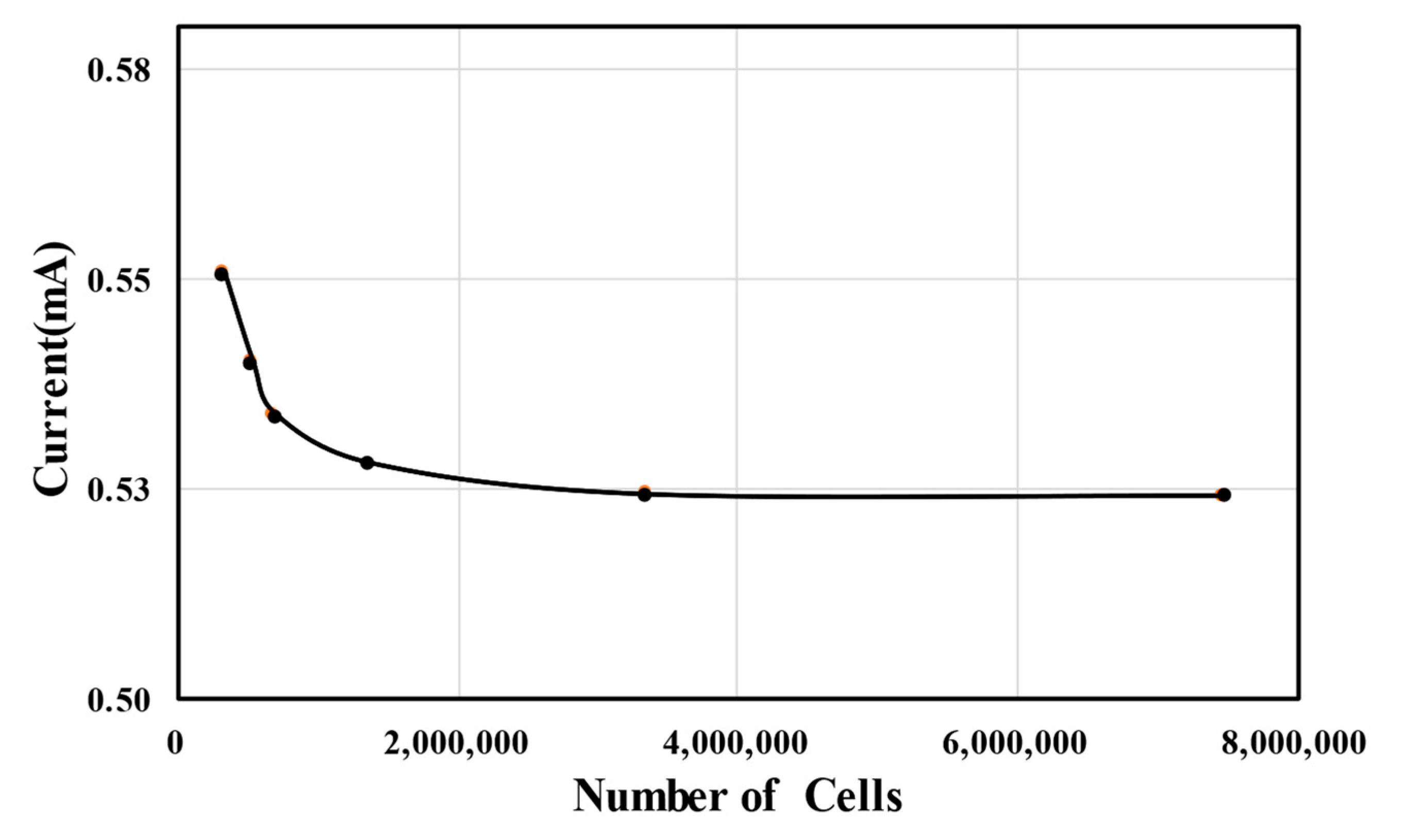
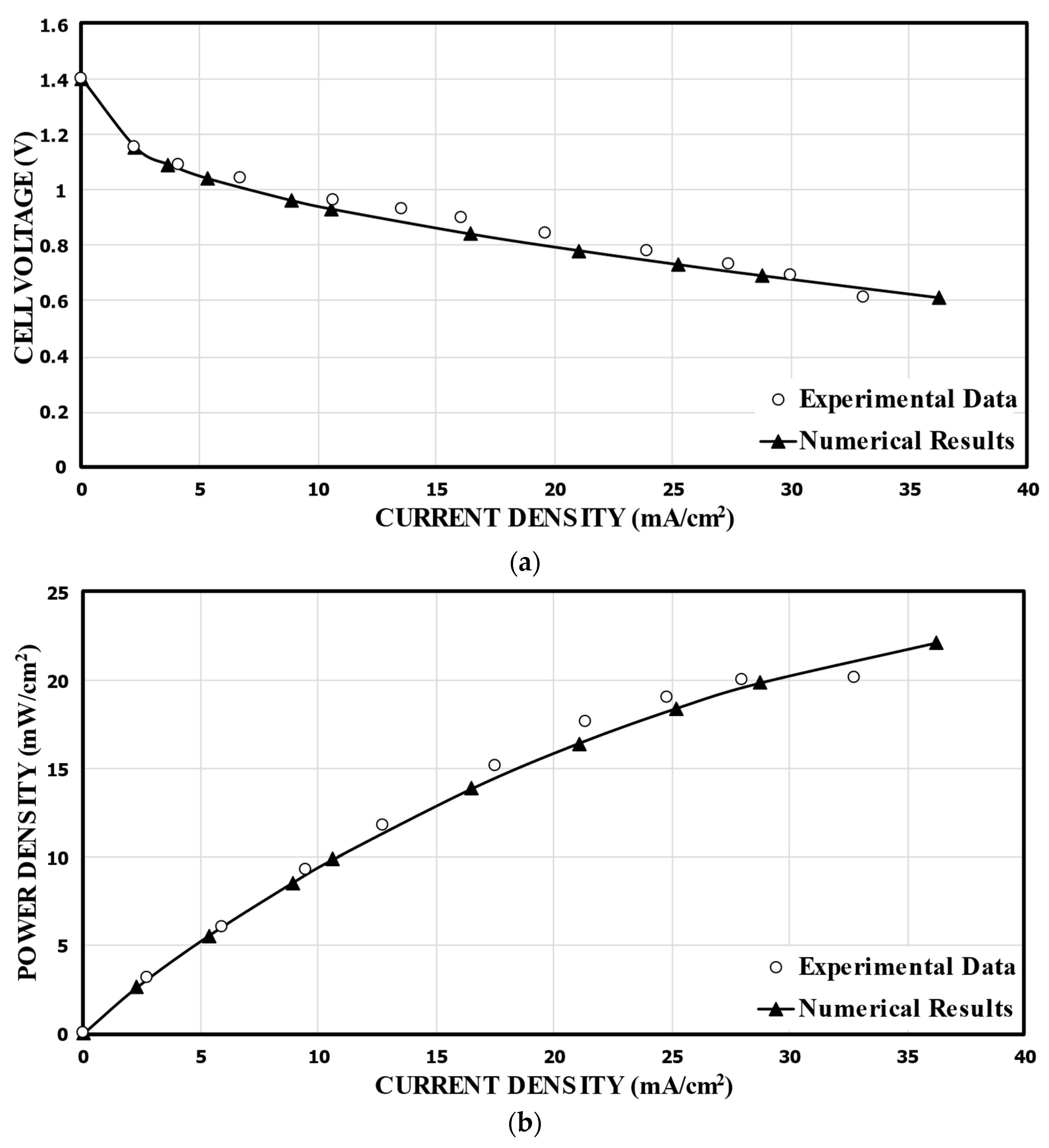

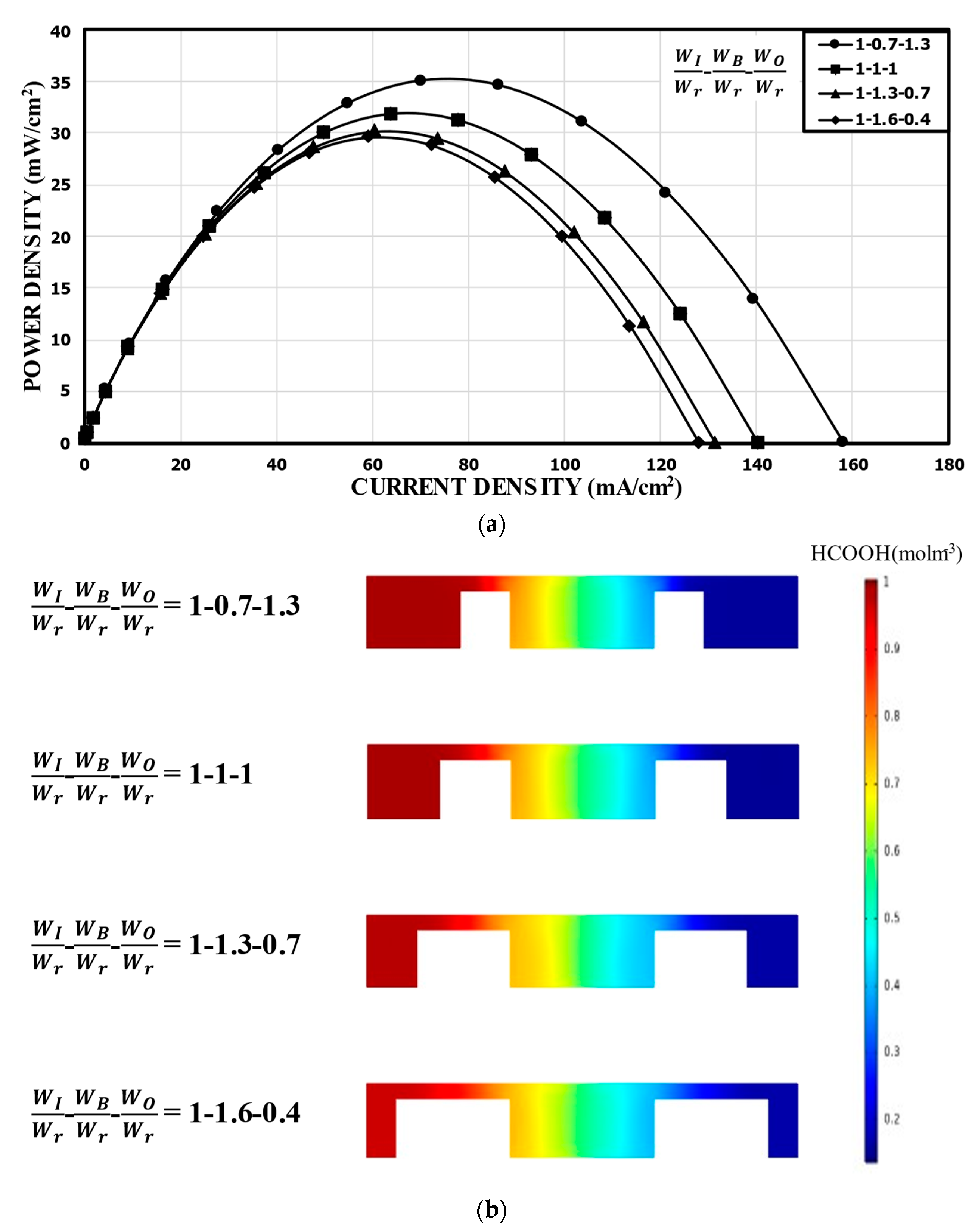

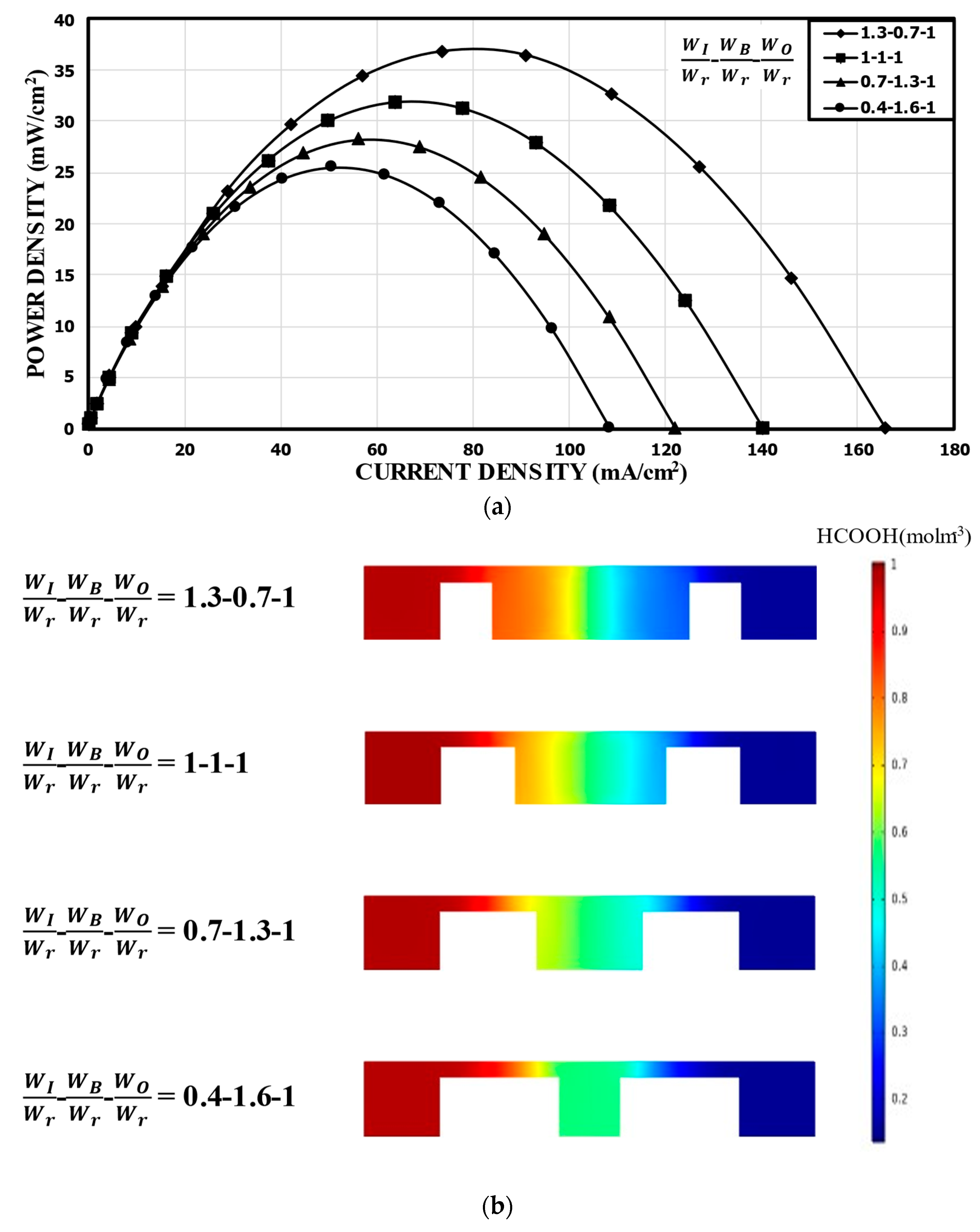
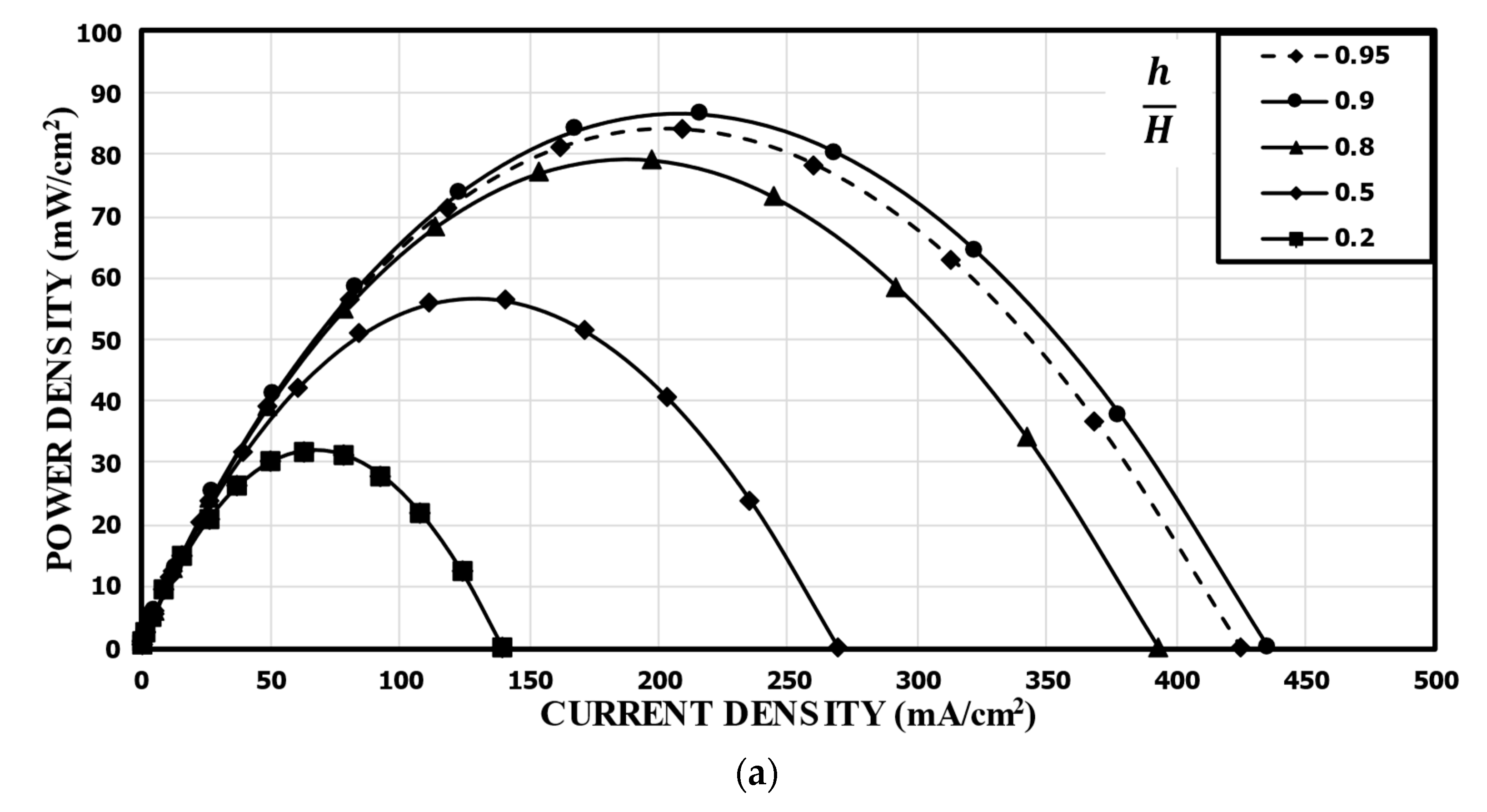
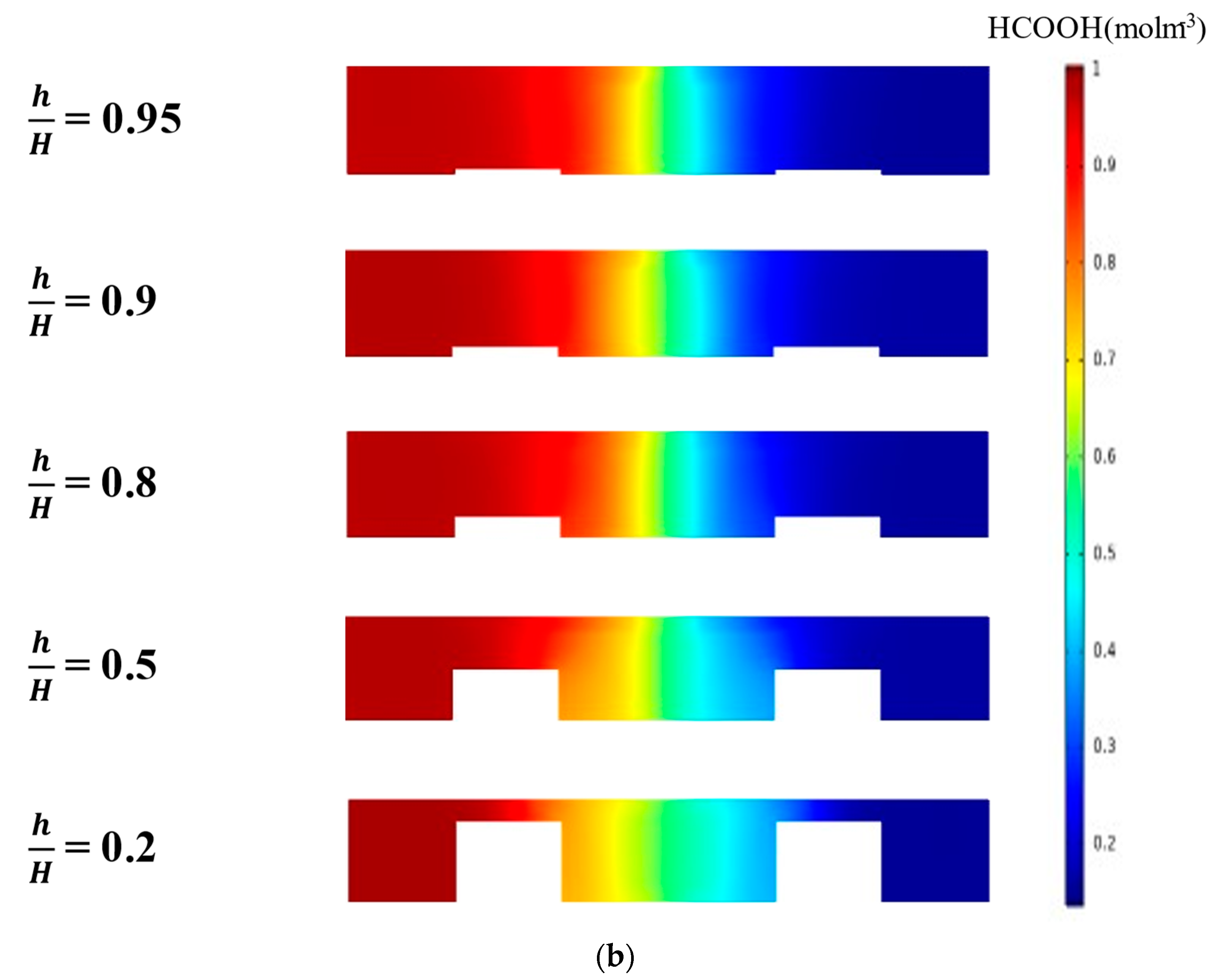
| Parameters | Values | |
|---|---|---|
| Number of cells | 3,341,684 | |
| 1,366,550 | ||
| 688,043 | ||
| Grid refinement factor | 1.3 | |
| Currents corresponding to N1, N2, and N3 (mA) | 0.5244 | |
| 0.5281 | ||
| 0.5339 | ||
| Apparent order | 2.0762 | |
| Extrapolated values | 52.37% | |
| Approximate relative error | 0.706% | |
| Extrapolated relative error | 0.131% | |
| Grid convergence index | 0.163% |
Publisher’s Note: MDPI stays neutral with regard to jurisdictional claims in published maps and institutional affiliations. |
© 2021 by the authors. Licensee MDPI, Basel, Switzerland. This article is an open access article distributed under the terms and conditions of the Creative Commons Attribution (CC BY) license (https://creativecommons.org/licenses/by/4.0/).
Share and Cite
Oh, J.-H.; Tanveer, M.; Kim, K.-Y. A Double-Bridge Channel Shape of a Membraneless Microfluidic Fuel Cell. Energies 2021, 14, 6973. https://doi.org/10.3390/en14216973
Oh J-H, Tanveer M, Kim K-Y. A Double-Bridge Channel Shape of a Membraneless Microfluidic Fuel Cell. Energies. 2021; 14(21):6973. https://doi.org/10.3390/en14216973
Chicago/Turabian StyleOh, Ji-Hyun, Muhammad Tanveer, and Kwang-Yong Kim. 2021. "A Double-Bridge Channel Shape of a Membraneless Microfluidic Fuel Cell" Energies 14, no. 21: 6973. https://doi.org/10.3390/en14216973
APA StyleOh, J.-H., Tanveer, M., & Kim, K.-Y. (2021). A Double-Bridge Channel Shape of a Membraneless Microfluidic Fuel Cell. Energies, 14(21), 6973. https://doi.org/10.3390/en14216973







